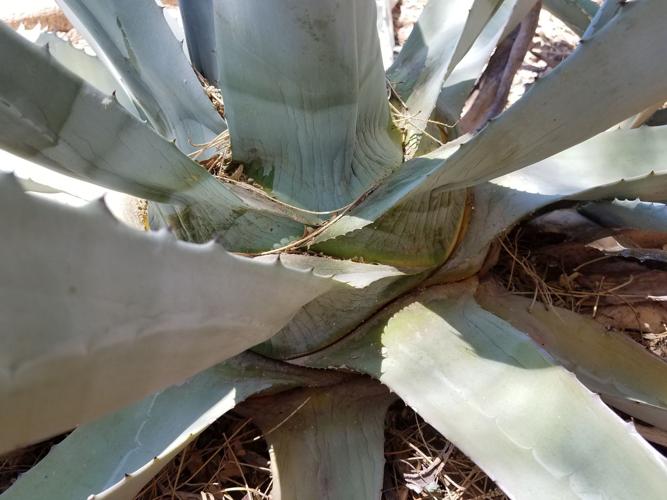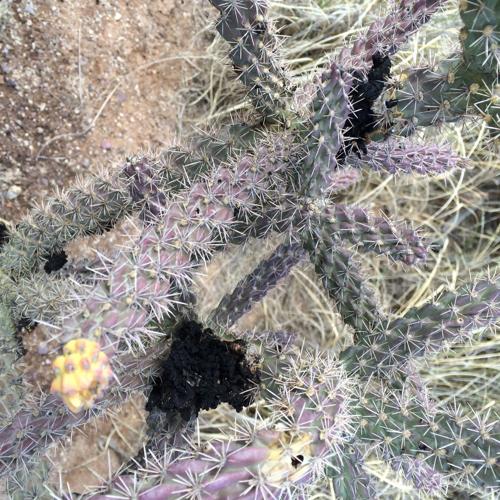Question: We were out this week just west of Huachuca City and noticed a couple of cholla with a dark substance. Please see the attached pics. Any idea if this is a bacteria or fungus?
Answer: This appears to be a species of sooty mold, which is a type of fungus. Sooty mold and related fungi are common, on a variety of plant species, and not harmful so they don’t get much attention.
Bacterial infections in cacti tend to be more of an oozing black liquid that runs down the side whereas fungi such as the sooty mold have fruiting bodies growing up and out from the plant.
Q: I have a single pine tree with a dead crown, which upon inspection revealed numerous entry holes with a reddish sap weeping on the bark. This made me do the internet thing, after reading many of the UA publications related to the bark beetle I stripped some bark off the tree exposing the signs of what I thought was this Dendroctonus beetle.
I’m not educated in entomology or trained in forestry. I attempted to photograph these little buggers but I’m not a photographer either. The first photo is a small black beetle about a ¼ inch long, there is another beetle in the same tunnel at the bottom, I guess, male and female with the brood chamber above the one in the photo.
The second photo is a large larva approximately one inch in length and quarter inch diameter I don’t know if this is the same insect or not but it was found in the same piece of bark that I stripped, but not the same tunnel as the black beetles. The crown is dead; these little black beetles were visible on the exterior of the bark.
I am concerned that my actions may be too late, but I choose to fight. I read numerous insecticide labels searching for anything that called the Dendroctonus beetle out in person. When I found Bifen XTS, on page 20 of the application instructions the Dendroctonus beetle is identified and sub species called out, including the IPS or engravers.
I have also seen a green iridescent beetle about one inch in length but alas could not find one to photograph. After reading for two days, I took action and ordered the insecticide, read the directions and applied to 40 surrounding trees. There are some signs of attack, but the tree with the dead crown appears to be our main infestation. So per directions I have destroyed that tree and sprayed the area.
I was reading on the internet again after my spraying when I found you. I have walked the neighborhood and not seen any other damage so I would sure like to stop this right here and now.
A: Your photos are very helpful. The small black beetle is an Ips pine engraver species although I cannot be sure which one from the photo. The main identifying characteristic is the back end of the beetle, which appears to be carved out and showing small spines on the edge of the hind end. These insects are attracted to stressed trees so the best defense against them is keeping your trees healthy by providing proper irrigation. Once they are established in the tree there isn’t anything you can do stop them so you can discontinue the insecticide treatments.
The second beetle, shown as a large larva in your second photo, appears to be a round-headed borer from the Cerambycidae family called the ponderosa pine bark borer. This insect avoids healthy trees so you know your tree was dying or dead if you find this in it.
In the end, your actions to take down and destroy the dead or dying tree were appropriate. I recommend planning to provide supplemental irrigation to nearby trees if that is feasible and to keep monitoring the trees for changes in crown color or evidence of beetle activity in the bark. Both beetle species are native and commonly found in this area and in the big picture, they are doing their job as decomposers of dying trees.
Q: As you can see from the attached photos I am having an issue with my agave plant. I have in the past lost plants, that once dead, revealed some type of black beetle infesting the leaves. Is there still hope for this plant? What can I do to prevent this problem from affecting the pups as well?
A: The black beetle infesting your plants is known as the agave weevil or Scyphophorus acupunctatus and is commonly found wherever agaves are grown. The adult female beetles lay eggs in the base of the plant in the spring. The larvae feed on the base of the plant and introduce bacteria that cause the rot and begin the process of killing the agave.
The plant in your photo is showing wrinkles at the base and is probably already rotting so I have little hope for that plant. You can try pulling on the leaves to see if it is loosely attached to the base. Diseased plants typically fall apart easily.
The weevils can spread to neighboring agaves but they tend to favor larger, more mature plants over pups and larger species over smaller ones.
If all of yours are the Agave americana species, you might consider replacing some with other smaller species or you can treat the soil at the base of your larger specimens with a systemic insecticide such as imidacloprid. This chemical is taken up through the plant roots and makes it poisonous. One treatment should be good for a year.
If an agave is about to bloom, applying an insecticide is not recommended. These plants die soon after blooming anyway and the chance of the insecticide being passed to pollinators through the nectar and pollen is something to be avoided. Please check the pesticide label for details along with safety precautions for applying it to protect yourself and other non-target organisms nearby.
Q: My parents planted a grapefruit tree in 1965 and it is still going strong and produces an enormous amount of fruit all year long. Is this normal?
A: Grapefruit trees can live past 50 years and continue to produce a good amount of fruit. While there are potential insect and disease problems that can shorten the life of these trees, sufficient irrigation and fertilization along with the right planting location will allow these trees to tolerate many small problems and still thrive.






